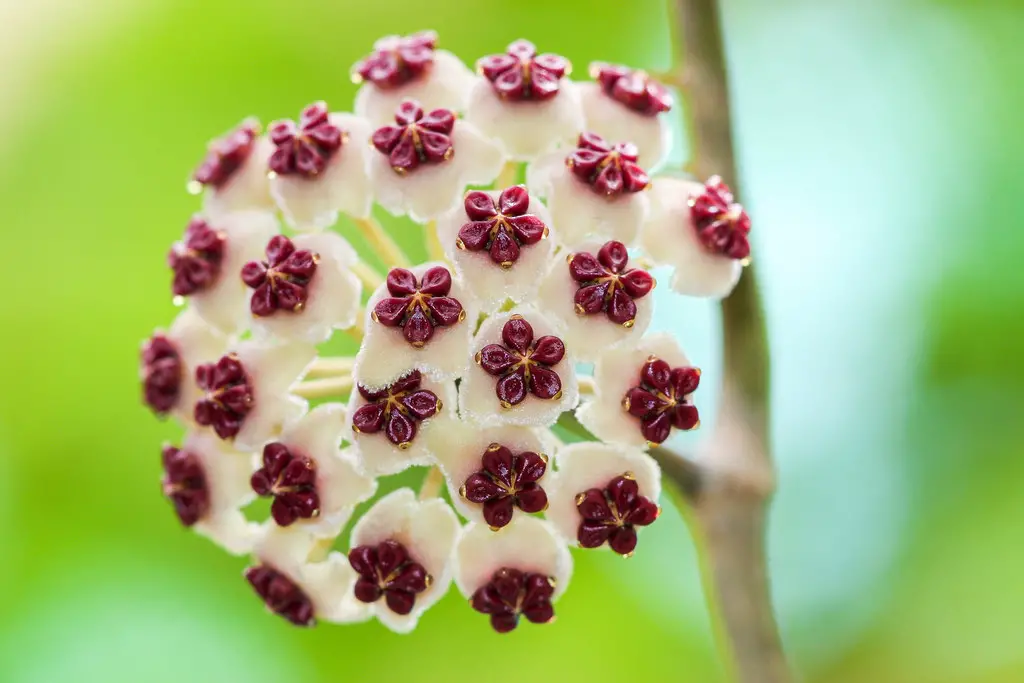Hoya Kerrii, often referred to as the Sweetheart Hoya or Valentine Hoya, is a striking plant renowned for its heart-shaped leaves. Native to Southeast Asia, this captivating succulent is a part of the large Apocynaceae family. Its unique leaves, which can grow up to 4 inches in size, are typically green, but some varieties may exhibit variegated or albino forms.
Flowering is another delightful aspect of Hoya kerrii. With the right care, mature plants can produce clusters of star-shaped, fragrant flowers, adding to the plant’s charm. The blossoms, usually in shades of white and pink, are not only visually appealing but emit a pleasing fragrance as well.
Hoya kerrii has become a popular gift item, especially during Valentine’s Day, symbolizing love and affection. Its distinctive appearance and relatively low-maintenance care requirements have contributed to its popularity as a houseplant. It’s an engaging addition to any interior space, bringing a touch of natural beauty and sentimentality.
| Attribute | Details |
|---|---|
| Common Names | Sweetheart Hoya, Valentine Hoya |
| Botanical Name | Hoya Kerrii |
| Family | Apocynaceae |
| Plant Type | Succulent |
| Mature Size | Up to 13 feet |
| Sun Exposure | Bright, indirect light |
| Soil Type | Well-draining, peat-based soil |
| Hardiness Zones | 10-11 |
| Native Area | Southeast Asia |
Hoya Kerrii Care
Caring for Hoya kerrii requires consideration of its native tropical habitat. Bright, indirect sunlight, and well-draining soil are crucial, along with balanced watering. While tolerant of some neglect, Hoya kerrii thrives when provided with consistent care that replicates its natural environment.
During its growing season, usually from spring to early fall, Hoya kerrii benefits from regular watering and occasional feeding. Being observant to its needs and responding appropriately will result in a healthy and content plant, potentially leading to the delightful bloom of its characteristic flowers.
Light Requirement for Hoya Kerrii
Hoya kerrii prefers bright, indirect sunlight. Direct exposure can scorch its leaves, while inadequate light may result in lackluster growth and absence of flowers. A spot near an east or west-facing window often offers the right amount of light.
Soil Requirements for Hoya Kerrii
A well-draining, peat-based soil mixed with perlite or sand facilitates optimal growth. Ensuring good drainage prevents the roots from rotting, while the right soil composition supports healthy development.
Water Requirements for Hoya Kerrii
Watering should be moderate, allowing the soil to dry slightly between watering sessions. Over-watering can lead to root rot, while under-watering may cause the leaves to dry and become brittle.
Temperature and Humidity
Maintaining a temperature between 60-80°F (15-27°C) and providing a humid environment mirrors Hoya kerrii’s natural habitat. Humidity trays or room humidifiers can be used to maintain the desired moisture levels.
Fertilizer
Feeding Hoya kerrii with a balanced, water-soluble fertilizer every 4-6 weeks during the growing season supports robust growth. Avoid over-fertilizing, which can cause more harm than good.
Pruning Hoya Kerrii
Pruning is generally unnecessary except for shaping or removing dead or damaged growth. Excessive pruning may hinder the plant’s natural growth pattern.
Propagating Hoya Kerrii
Propagation is typically achieved through stem cuttings. Cut a healthy stem, preferably with a leaf attached, and place it in water or soil until it develops roots.
How To Grow Hoya Kerrii From Seed
Growing Hoya kerrii from seed is a slow and challenging process. The seeds must be sown in a well-draining medium, kept warm, and provided with consistent moisture and indirect light.
Common Pests & Plant Diseases
Mealybugs
Mealybugs can be treated with insecticidal soap or neem oil.
Spider Mites
Spider mites may appear and can be controlled with regular misting and wiping of the leaves.
Common Problems With Hoya Kerrii
Yellowing Leaves
Yellowing leaves often indicate over-watering. Adjust the watering schedule and ensure proper drainage.
Lack of Flowering
Lack of flowering may be caused by inadequate light or improper feeding. Adjusting these factors may stimulate blooming.
Pro Tips
- Avoid repotting too often, as Hoya kerrii prefers to be somewhat root-bound.
- Provide bright, indirect sunlight for best growth and flowering potential.
- Monitor watering closely, as both over-watering and under-watering can lead to issues.
- Propagation through stem cuttings is usually the most successful method.




